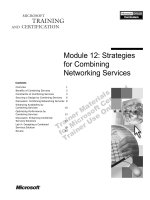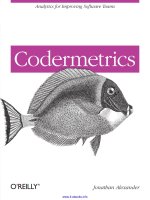Advanced Video Coding for Next-Generation Multimedia Services pot
Bạn đang xem bản rút gọn của tài liệu. Xem và tải ngay bản đầy đủ của tài liệu tại đây (10.52 MB, 210 trang )
ADVANCED VIDEO
GENERATION
MULTIMEDIA SERVICES
CODING FOR
NEXT-
Edited by Yo-Sung Ho
ADVANCED VIDEO
CODING FOR NEXT-
GENERATION
MULTIMEDIA SERVICES
Edited by Yo-Sung Ho
Advanced Video Coding for Next-Generation Multimedia Services
/>Edited by Yo-Sung Ho
Contributors
Yo-Sung Ho, Jung-Ah Choi, Wen-Liang Hwang, Guan-Ju Peng, Kwok-Tung Lo, Gulistan Raja, Muhammad Riaz Ur
Rehman, Ahmad Khalil Khan, Haibing Yin, Mohd Fadzli Mohd Salleh, BenShung Chow, Ulrik Söderström, Haibo Li,
Holger Meuel, Julia Schmidt, Marco Munderloh, Jörn Ostermann
Published by InTech
Janeza Trdine 9, 51000 Rijeka, Croatia
Copyright © 2012 InTech
All chapters are Open Access distributed under the Creative Commons Attribution 3.0 license, which allows users to
download, copy and build upon published articles even for commercial purposes, as long as the author and publisher
are properly credited, which ensures maximum dissemination and a wider impact of our publications. After this work
has been published by InTech, authors have the right to republish it, in whole or part, in any publication of which they
are the author, and to make other personal use of the work. Any republication, referencing or personal use of the
work must explicitly identify the original source.
Notice
Statements and opinions expressed in the chapters are these of the individual contributors and not necessarily those
of the editors or publisher. No responsibility is accepted for the accuracy of information contained in the published
chapters. The publisher assumes no responsibility for any damage or injury to persons or property arising out of the
use of any materials, instructions, methods or ideas contained in the book.
Publishing Process Manager Ana Pantar
Technical Editor InTech DTP team
Cover InTech Design team
First published December, 2012
Printed in Croatia
A free online edition of this book is available at www.intechopen.com
Additional hard copies can be obtained from
Advanced Video Coding for Next-Generation Multimedia Services, Edited by Yo-Sung Ho
p. cm.
ISBN 978-953-51-0929-7
Contents
Preface VII
Section 1 Advanced Video Coding Techniques 1
Chapter 1 Differential Pixel Value Coding for HEVC Lossless
Compression 3
Jung-Ah Choi and Yo-Sung Ho
Chapter 2 Multiple Descriptions Coinciding Lattice Vector Quantizer for H.
264/AVC and Motion JPEG2000 21
Ehsan Akhtarkavan and M. F. M. Salleh
Chapter 3 Region of Interest Coding for Aerial Video Sequences Using
Landscape Models 51
Holger Meuel, Julia Schmidt, Marco Munderloh and Jörn
Ostermann
Chapter 4 Compensation Methods for Video Coding 79
Ben-Shung Chow
Section 2 Video Coding for Transmission 99
Chapter 5 Error Resilient H.264 Video Encoder with Lagrange Multiplier
Optimization Based on Channel Situation 101
Jian Feng, Yu Chen, Kwok-Tung Lo and Xu-Dong Zhang
Chapter 6 Optimal Bit-Allocation for Wavelet Scalable Video Coding with
User Preference 117
Guan-Ju Peng and Wen-Liang Hwang
Chapter 7 Side View Driven Facial Video Coding 139
Ulrik Söderström and Haibo Li
Section 3 Hardware-Efficient Architecture of Video Coder 155
Chapter 8 Algorithm and VLSI Architecture Design for MPEG-Like High
Definition Video Coding‐AVS Video Coding from Standard
Specification to VLSI Implementation 157
Haibing Yin
Chapter 9 Implementation of Lapped Biorthogonal Transform for JPEG-
XR Image Coding 187
Muhammad Riaz ur Rehman, Gulistan Raja and Ahmad Khalil Khan
ContentsVI
Preface
In recent years, various multimedia services have become available and the demand for high-
quality visual information is growing rapidly. Digital image and video data are considered as
valuable assets in the modern era. Like many other recent developments, image and video coding
techniques have been advanced significantly during the last decade. Several international
activities have been carried out to develop image and video coding standards, such as MPEG and
H.264/AVC, to provide high visual quality while reducing storage and transmission
requirements.
This book aims to bring together recent advances and applications of video coding. All chapters
can be useful for researchers, engineers, graduate and postgraduate students, experts in this area,
and hopefully also for people who are generally interested in video coding. The book includes
nine carefully selected chapters. The chapters deal with advanced compression techniques for
multimedia applications, concerning recent video coding standards, high efficiency video coding
(HEVC), multiple description coding, region of interest (ROI) coding, shape compensation, error
resilient algorithms for H.264/AVC, wavelet-based coding, facial video coding, and hardware
implementations. This book provides several useful ideas for your own research and helps to
bridge the gap between the basic video coding techniques and practical multimedia applications.
We hope this book is enjoyable to read and will further contribute to video coding.
This book is divided in three parts and has nine chapters in total. All the parts of the book are
devoted to novel video coding algorithms and techniques for multimedia applications. First four
chapters in Part 1 describe new advances in the state-of-the-art video coding techniques, such as
lossless high efficiency video coding (HEVC), multiple description video coding, region of
interest video coding, and shape compensation methods. Part 2 concentrates on channel-friendly
video coding techniques for real-time communications and data transmission, including error
reconstruction over the wireless packet-switched network, optimal rate allocation for wavelet-
based video coding, and facial video coding using the side view. Part 3 is dedicated to the
architecture design and hardware implementation of video coding schemes.
The editor would like to thank the authors for their valuable contribution to this book, and the
editorial assistance provided by the INTECH publishing process managers Ms. Ana Pantar and
Ms. Sandra Bakic. Last but not least, the editor’s gratitude extends to the anonymous manuscript
processing team for their arduous formatting work.
Yo-Sung Ho
Professor
Gwangju Institute of Science and Technology
Republic of Korea
Section 1
Advanced Video Coding Techniques
Chapter 1
Differential Pixel Value Coding for
HEVC Lossless Compression
Jung-Ah Choi and Yo-Sung Ho
Additional information is available at the end of the chapter
/>1. Introduction
High efficiency video coding (HEVC) [1] is a new video coding standard developed by Joint
Collaborative Team on Video Coding (JCT-VC) of ITU-T Video Coding Experts Group
(VCEG) and ISO/IEC Moving Picture Experts Group (MPEG). Currently, most of coding
techniques are established and HEVC version 1 will be released in January 2013 [2]. We ex‐
pect that HEVC is widely used in various applications for recording, compression, and dis‐
tribution of high-resolution video contents [3].
Lossless compression is useful when it is necessary to minimize the storage space or trans‐
mission bandwidth of data while still maintaining archival quality. Many applications such
as medical imaging, preservation of artwork, image archiving, remote sensing, and image
analysis require the use of lossless compression, since these applications cannot allow any
distortion in the reconstructed images [4].
With growing demand for these applications, JCT-VC included the lossless coding mode in the
HEVC test model (HM) software in consequence of the Ad Hoc group for lossless coding [5]. In
lossless coding, no distortion is allowed in reconstructed frames. To achieve lossless coding,
transform, quantization, their inverse operations, and all in-loop filtering operations including
deblocking filter, sample adaptive offset (SAO), and adaptive loop filter (ALF) are bypassed in
the encoder and decoder since they are not reversible in general [6]. Also, sample-based angu‐
lar prediction (SAP) [7][8] is used to replace the existing intra prediction method.
In the 7th JCT-VC meeting, many lossless coding solutions were proposed. Mode dependent
residual scanning (MDRS) and multiple scanning positions for inter coding are suggested
[9]. Also, SAP and lossless transforms [10] are proposed. Among these proposals, SAP is
adopted in the HEVC standard. In the next 8th JCT-VC meeting, efforts to find the efficient
lossless coding solutions continued. Joint proposal that combines SAP and the lossless cod‐
ing signaling method was submitted [5] and a simplified context-based adaptive binary
arithmetic coding (CABAC) structure without last position coding [11] was introduced.
Since the development of the HEVC lossless mode is not yet finished, many experts are ac‐
tively researching efficient algorithms for lossless coding [12][13].
In this chapter, we have tried to design an efficient differential pixel coding method for the
HEVC lossless mode. One caution in developing the HEVC lossless mode is that the coding
performance of the HEVC lossy mode would not be impacted or compromised. In lossless
coding, the residual data is not quantized transform coefficients but differential pixel after
prediction. As a result, the residual data in lossless coding has different characteristics than
that in lossy coding. Thus, we analyze characteristics of the residual data in lossless coding
and propose efficient mode dependent differential pixel scanning and entropy coding using
the modified binarization. Note that the proposed method does not require any modifica‐
tion of syntax elements in HEVC, so it can be easily applied to the current standard. More‐
over, the amount of complexity increase is negligible.
The chapter is organized as follows. In Section 2, we briefly present an overview of the
HEVC lossless mode including its structure, SAP, scanning, and entropy coding. In Section
3, after we analyze characteristics of residual data in lossless coding, the proposed method
for differential pixel value coding is explained. In Section 4, the performance of the pro‐
posed method is compared to the performance of the HEVC lossless mode in terms of bit
saving and complexity. Finally, conclusions are presented in Section 5.
2. Overview of the HEVC lossless mode
The basic approach for lossless coding is to bypass transform and quantization in the encod‐
er and the decoder. Without transform and quantization, SAP can be incorporated to im‐
prove coding efficiency of the lossless mode. It replaces the general angular intra prediction
method in the HEVC lossy mode.
When the lossless mode is applied, all the in-loop filtering operations including deblocking
filter, SAO, and ALF are also bypassed. Since there is no distortion existing in the recon‐
structed frame in the lossless mode, in-loop filtering operations will not help either picture
quality or coding efficiency. The overall structure of the HEVC lossless mode is shown in
Figure 1. In Figure 1, dashed lines represent the bypass and all bypass operations are acti‐
vated in the HEVC lossless mode. Main coding modules are explained in detail in following
sub-sections.
2.1. Sample-based angular prediction
In order to explore spatial sample redundancy in intra-coded frame, SAP is employed in‐
stead of general HEVC intra prediction. As shown in Figure 2, 33 angles are defined and
these angles are categorized into two classes: vertical and horizontal angular prediction.
Each prediction has both negative and positive angles.
Advanced Video Coding for Next-Generation Multimedia Services
4
Figure 1. Encoder structure of the HEVC lossless mode
Figure 2. Intra prediction angles (vertical and horizontal angular prediction)
Differential Pixel Value Coding for HEVC Lossless Compression
/>5
In lossless coding, reference samples within the current prediction unit (PU) as well as
neighboring samples of the current PU are available. Thus, prediction can be performed
sample by sample to achieve better intra prediction accuracy. All samples within a PU use a
same prediction angle and the signaling method of the prediction angle is exactly same as
that in lossy intra coding.
In SAP, samples in a PU are processed in pre-defined orders. The raster scanning and verti‐
cal scanning processing order is applied to vertical and horizontal angular prediction, re‐
spectively. In addition, reference samples around right and bottom PU boundaries of the
current PU are padded from the closest boundary samples of the current PU.
Figure 3 presents the reference sample locations a and b relative to the current sample x to
be predicted for horizontal and vertical angular prediction with negative and positive pre‐
diction angles. At most two reference samples are selected for each sample to be predicted
in the current PU. Depending on the current sample location and the selected prediction an‐
gle, reference sample a and b can be neighboring PUs, padded samples, or samples inside
the current PU. The interpolation for prediction sample generation is exactly same as that in
lossy coding.
Figure 3. Reference sample locations relative to the current sample for sample-based angular intra prediction
Advanced Video Coding for Next-Generation Multimedia Services
6
2.2. Mode dependent coefficient scanning
In HEVC intra coding, mode dependent coefficient scanning (MDCS) [14] is used. There are
three scan patterns: diagonal [15], horizontal, and vertical, as shown in Figure 4. The each
scanning pattern is represented by the scan index. Index 1 and index 2 are assigned for hori‐
zontal and vertical scans, respectively. For diagonal scan, index 3 is assigned. Scanning pat‐
tern for the current transform unit (TU) is determined by the intra prediction mode and the
TU size using a fixed look-up table.
(a) Diagonal scan
(b) Horizontal scan
(c) Vertical scan
Figure 4. Three scanning patterns: diagonal, horizontal, vertical scans
Table 1
shows the look-up table that is used for the scan index selection. The look-up table is
changed from the earlier version of MDCS. That is because the defined intra prediction
mode number is changed in consecutive order. Here, the first row of the table indicates the
intra prediction mode. The first column of the table represents the TU size. According to in‐
formation of the intra prediction mode and the TU size, we can find the appropriate scan
index using Table 1.
0
1 2 3 4 5 6 7 8 9 10 11 12 13 14 15 16 17 18 19 20 21 22 23 24 25 26 27 28 29 30 31 32 33 34
32x32 3 3 3 3 3 3 3 3 3 3 3 3 3 3 3 3 3 3 3 3 3 3 3 3 3 3 3 3 3 3 3 3 3 3 3
16x16 3 3 3 3 3 3 3 3 3 3 3 3 3 3 3 3 3 3 3 3 3 3 3 3 3 3 3 3 3 3 3 3 3 3 3
8x8 3 3 3 3 3 3 2 2 2 2 2 2 2 2 2 3 3 3 3 3 3 3 1 1 1 1 1 1 1 1 1 3 3 3 3
4x4 3 3 3 3 3 3 2 2 2 2 2 2 2 2 2 3 3 3 3 3 3 3 1 1 1 1 1 1 1 1 1 3 3 3 3
Table 1. Look-up table for the intra coefficient scan index selection
2.3. Entropy coding
2.3.1. Syntax elements of CABAC
HEVC employed context-based adaptive binary arithmetic coding (CABAC) as an entropy
coder. The syntax elements employed in CABAC are shown in Table 2. The gray shaded
syntax elements are encoded in TU level and others are encoded in 4×4 sub-TU level.
Differential Pixel Value Coding for HEVC Lossless Compression
/>7
last_significant_coeff_x_prefix
last_significant_coeff_y_prefix
last_significant_coeff_x_suffix
last_significant_coeff_y_suffix
significant_coeff_group_flag
significant_coeff_ flag
coeff_abs_level_greater1_flag
coeff_abs_level_greater2_flag
coeff_sign_flag
coeff_abs_level_remaining
Table 2. CABAC syntax elements for a transform unit (TU)
Last Significant Coefficient Position Coding: Since HEVC employs big coding unit up to 64x64,
the location of the last significant coefficient in a TU is encoded by the column and the row
position. For a TU larger than 4x4, the syntax element is separated into two parts: prefix and
suffix. Prefix and suffix parts are encoded using truncated unary code and fixed length code,
respectively. Table 3 shows the codeword structure for syntax elements of last significant co‐
efficient position. In Table 3, (1) only exists when the TU size is greater than the largest last
position that the code can represent and X means 0 or 1.
Magnitude of last coefficient
position
Prefix
(Truncated Unary Code)
Suffix
(Fixed Length Code)
0 1 -
1 01 -
2 001 -
3 000(1) -
4-5 00001 X
6-7 00000(1) X
8-11 0000001 XX
12-15 0000000(1) XX
16-23 000000001 XXX
24-31 000000000 XXX
Table 3. Codeword structure for syntax elements of last significant coefficient position
Advanced Video Coding for Next-Generation Multimedia Services8
Significance Map Coding: After encoding of the position of last significant coefficient, signifi‐
cance map is encoded. There are two syntax elements, significant_coeff_group_flag and sig‐
nificant_coeff_flag. sgnificant_coeff_group_flag indicates that a 4x4 array of 16 transform
coefficient level within the current TU has non-zero transform coefficient level. Then, for
non-zero significant coefficient group, one bit symbol significant_coeff_flag is encoded in
scanning order. If significant_coeff_flag is one, the transform coefficient level at the corre‐
sponding location has a non-zero value.
Level Information Coding: After the encoded significance map determines locations of all sig‐
nificant coefficients inside the TU, level information is encoded by using four syntax ele‐
ments, including coeff_abs_level_greater1_flag, coeff_abs_level_greater2_flag,
coeff_sign_flag, and coeff_abs_level_remaining. First two syntax elements indicate whether
the quantized transform coefficient level value at the corresponding scanning position is
greater than 1 and 2, respectively. Then, coeff_sign_flag is encoded. It specifies the sign of
the coefficient. After this, the syntax element for the absolute value of the coefficient level
minus three (coeff_abs_level_remaining) is binarized and encoded.
2.3.2. Binarization of level information
In order to binarize level information, the codeword is assigned as follows. Given a particu‐
lar parameter k, an absolute transform coefficient n to be coded is consists of prefix part and
a suffix part. The prefix is coded using a truncated unary code and the suffix is coded using
a variable length code, as shown in Table 4. As shown in Table 4, the length of the variable
length code depends on the unary code and the parameter k. That is, the parameter k con‐
trols the length of the codeword structure. Table 5 shows the binarization of coeff_abs_lev‐
el_remaining when the parameter k is equal to 1.
Value
Prefix Suffix (in bits)
0 ~ 1×2
k
-1 0 k
1×2
k
~ 2×2
k
-1 10 k
2×2
k
~ 3×2
k
-1 110 k
3×2
k
~ 4×2
k
-1 1110 k
4×2
k
~ 5×2
k
-1 11110 k
5×2
k
~ 6×2
k
-1 111110 k
6×2
k
~ 7×2
k
-1 1111110 k
7×2
k
~ 8×2
k
-1 11111110 k
8×2
k
~ 9×2
k
-1 111111110 k
9×2
k
~ 11×2
k
-1 1111111110 k + 1
11×2
k
~ 15×2
k
-1 11111111110 k + 2
15×2
k
~ 23×2
k
-1 111111111110 k + 3
… … …
Table 4. Binarization method for level information
Differential Pixel Value Coding for HEVC Lossless Compression
/>9
Value Prefix Suffix
0 0 0
1 0 1
2 10 0
3 10 1
4 110 0
5 110 1
6 1110 0
7 1110 1
… … …
18 1111111110 00
19 1111111110 01
20 1111111110 10
… … …
Table 5. Example of binarization for level information when k = 1
The update of the parameter based on the magnitude of the previously encoded absolute
level value. After encode one level value, the update mechanism is conducted, as shown in
Eq. (1).
3 2 , ' min( 1, 4)
k
If x k k> × = +
(1)
Here, x indicates the previously encoded level value, k is the parameter, and k’ is the updat‐
ed parameter. The parameter k ranged from 0 to 4. Based on the pseudo code, we can sum‐
marize the selected parameter according to the absolute level range.
Parameter
Absolute Level
0 0, 1, 2, 3
1 4, 5, 6
2 7, 8, , 12
3 13, 14, , 24
4 25, 26, , ∞
Table 6. Absolute level range for determining the parameter
Advanced Video Coding for Next-Generation Multimedia Services10
In level information coding, the absolute value of each non-zero coefficient is adaptively en‐
coded by a codeword structure with the selected parameter k. The codeword with certain
parameter is designed to encode efficiently in a specified range of the absolute level, as de‐
scribed in Table 6. We can note that the parameter monotonically increases according to the
previously encoded absolute level. That is because level coding in CABAC is based on the
expectation that absolute level is likely to increase at low frequencies.
4. Efficient differential pixel value coding
In this section, we introduce an efficient differential pixel value coding method. The pro‐
posed method consists of two parts: mode dependent differential pixel scanning and level
information coding with modified binarization.
4.1. Mode dependent differential pixel scanning
In the HEVC scanning method, the horizontal scan is used for a vertically predicted block.
In the similar way, for a horizontally predicted block, the vertical scan is used. Undoubted‐
ly, SAP significantly improves coding efficiency of intra prediction in lossless coding. How‐
ever, since the current sample cannot exactly predicted by reference samples and there is no
transform and quantization processes, correlation in the prediction direction still remains.
Thus, the conventional scanning index mapping in HEVC cannot provide the best coding
performance for lossless video coding.
In lossless coding, intra predicted residuals do not show the same behavior as transformed
coefficients. Instead, it is observed that for relatively small TU, e.g. an 8x8 or a 4x4 TU, when
intra prediction is in vertical direction, the residual will often appear in vertical direction.
Thus, a vertical scan will often result in better performance. Similarly, when the intra predic‐
tion is in horizontal direction, a horizontal scan will often be better. It is motivation of
MDRS [16] and we follow this observation.
We assign the vertical scanning pattern to the vertically predicted block and the horizontal
pattern to the horizontally predicted block. However, MDRS is proposed for the HEVC test
model (HM) 4.0 and the current HEVC standard uses the different intra prediction mode
number. Hence, we change the scan index selection to fit the current HEVC intra prediction
mode number, as shown in Table 7.
0 1 2 3 4 5 6 7 8 9 10 11 12 13 14 15 16 17 18 19 20 21 22 23 24 25 26 27 28 29 30 31 3233 34
32x32 3 3 3 3 3 3 3 3 3 3 3 3 3 3 3 3 3 3 3 3 3 3 3 3 3 3 3 3 3 3 3 3 3 3 3
16x16 3 3 3 3 3 3 3 3 3 3 3 3 3 3 3 3 3 3 3 3 3 3 3 3 3 3 3 3 3 3 3 3 3 3 3
8x8 3 3 3 3 3 3 1 1 1 1 1 1 1 1 1 3 3 3 3 3 3 3 2 2 2 2 2 2 2 2 2 3 3 3 3
4x4 3 3 3 3 3 3 1 1 1 1 1 1 1 1 1 3 3 3 3 3 3 3 2 2 2 2 2 2 2 2 2 3 3 3 3
Table 7. Modified look-up table for the scan index selection
Differential Pixel Value Coding for HEVC Lossless Compression
/>11
In lossless coding, these differential pixel values are likely to be the end of the PU. As men‐
tioned in Section 2, padded samples are produced and used as reference samples in the pre‐
diction process. Figure 5 shows an example that a padded sample is used as reference
sample. Here, the padded samples are copied from the closest neighboring sample s. Strictly
speaking, these padded samples are not actual neighboring samples of the current sample x
and samples that uses these padded samples as reference samples might provide poor pre‐
diction performance. It results in the increase of the residual data.
Figure 5. Two types of padded samples in the sample-based angular prediction
Since syntax elements in the entropy coder are encoded in the reverse order, the beginning
part of the scanned coefficient sequence has a higher probability of having non-zero coeffi‐
cients compared with the ending part. In this way, the resultant scanned sequence is more
suitable for the entropy coding method and experimental results verify that considerable bit
saving is achieved. Thus, we change the scan order. For each scanning pattern, we change
the scan order in the opposite order of the conventional scanning method.
4.2. Level information coding with modified binarization
As mentioned, in lossless coding, the residual data is the differential pixel values between
the original and the predicted pixel values without transform and quantization. Main differ‐
ence between differential pixel values in lossless coding and quantization transform coeffi‐
cients of lossy coding is the magnitude of the level information. Figure 6 shows the
magnitude distribution of coeff_abs_level_remaining in lossy and lossless coding. We can
observe that differential pixel values have much bigger level information than quantized
transform coefficients in lossy coding. In other words, differential pixel values have a wide
range of magnitudes.
Advanced Video Coding for Next-Generation Multimedia Services
12
Hence, in our binarization, we extend the parameter range from 0 to 6. The parameter is ini‐
tially set to zero. The parameter monotonically increases based on Eq. (2).
3 2 , ' min( 1, 6)> × = +
k
If x k k
(2)
It contributes the coding performance of the proposed method since it provides appropriate
binarization code for bigger level values. The construction method of codeword is same
with conventional HEVC coding, as described in Section 2.
Figure 6. Magnitude distribution of coeff_abs_level_remaining
Differential Pixel Value Coding for HEVC Lossless Compression
/>13
5. Experimental results and analysis
In order to verify coding efficiency of the proposed method, we performed experiments on
several test sequences of YUV 4:2:0 and 8 bits per pixel format [17]. Two UHD (2560×1600)
sequences, five HD (1920×1080) sequences, four WVGA(832×480) sequences, and four
WQVGA(416×240) sequences with 100 frames are used. Specifically, the sequences that we
used are summarized in Figure 7. The proposed method is implemented in HM 7.0 [18]. Ta‐
ble 8 shows the encoding parameters for the reference software.
Parameter Value Description
CUWidth 64
Largest CU size = 64x64
CUHeight 64
IntraPeriod 1 Intra only coding
QP 0 Lossless coding
InternalBitDepth 8 8 bit per pixel
LosslessCuEnabled 1 Lossless coding
LoopFilterDisable 1 No deblocking filter
SAO 0 No sample adaptive offset
ALF 0 No adaptive loop filter
Table 8. Encoding parameters
In order to evaluate the efficiency of the proposed method, we include two sections based
on the following settings.
• MethodI: Mode dependent differential pixel scanning
• Method II: MethodI + Entropy coding with modified binarization
5.1. Coding performance comparison
To verify the performance of the proposed method, we evaluate the compression results us‐
ing bit saving. The definition of the measure is shown in Eq. (3). In the bit saving, negative
value represents higher compression efficiency.
(%) 100
Method HEVC LS
HEVC LS
Bitrate Bitrate
Bit Saving
Bitrate
-
-
-
= ´
(3)
Advanced Video Coding for Next-Generation Multimedia Services14
Book Title
12
1
(a) Traffic (UHD) (b) PeopleOnStreet (UHD) (c) Kimono (HD) 2
3
(d) ParkScene(HD) (e) Cactus (HD) (f) BasketballDrive (HD) 4
5
(g) BQTerrace(HD) (h) BasketballDrill (WVGA) (i) BQMall (WVGA) 6
7
(j) PartyScene (WVGA) (k) RaceHorses (WVGA) (l) BasketballPass (WQVGA) 8
9
(m) BQSquare (WQVGA) (n) BlowingBubbles (WQVGA) (o)RaceHorses (WQVGA) 10
Figure 7.HEVC common test sequences 11
Figure 7. HEVC common test sequences
Differential Pixel Value Coding for HEVC Lossless Compression
/>15
Sequence
HEVC lossless
mode
(bytes)
Proposed Method
Bit Saving of
Method I
(%)
Bit Saving of
Method II
(%)
Method I
(bytes)
Method II
(bytes)
Traffic 292043389 289021760 288978917 -1.03 -1.05
PeopleOnStreet 285283752 279453835 279453835 -2.04 -2.10
Kimono 135252302 135252302 134976664 -0.20 -0.21
ParkScene 162834309 162834309 161872833 -0.59 -0.60
Cactus 165415216 165415216 164741620 -0.41 -0.42
BasketballDrive 142954441 142954441 142590363 -0.25 -0.26
BQTerrace 159248773 159248773 158651984 -0.37 -0.43
BasketballDrill 29015828 29015828 28759282 -0.88 -0.90
BQMall 31047873 31047873 30892776 -0.50 -0.52
PartyScene 38443400 38443400 38237571 -0.54 -0.54
RaceHorses 31042618 31042618 30855443 -0.60 -0.59
BasketballPass 6938810 6938810 6853810 -1.22 -1.24
BQSquare 8940364 8940364 8893462 -0.52 -0.83
BlowingBubbles 9009542 9009542 8975937 -0.37 -0.37
RaceHorses 8309686 8309686 8249459 -0.72 -0.79
Average -0.69 -0.72
Table 9. Comparison of bit savings for the HEVC lossless mode and the proposed method
Experimental results are presented in Table 9. It can be seen that the proposed method gives
additional compression efficiency about 0.72% bit savings on average and 2.10% bit savings
at maximum compared to the HEVC lossless mode. From Table 9, we confirmed that the
proposed method provided better coding performance, compared to the conventional
HEVC lossless mode.
5.2. Encoding time comparison
To verify the complexity of the proposed method, we check encoding time of the proposed
method and the conventional HEVC lossless mode. Then, we calculate the encoding time
change (∆EncodingTime), as defined in Eq. (4). Here, negative value means the complexity re‐
duction and positive value means the complexity increase.
(%) 100
Method HEVC LS
HEVC LS
EncodingTime EncodingTime
EncodingTime
EncodingTime
-
-
-
D = ´
(4)
Advanced Video Coding for Next-Generation Multimedia Services16
The complexity comparison results are presented in Table 10. In general, the most time con‐
suming part in intra lossless coding is not the prediction part, but residual data coding.
However, since the proposed method follows the statistical results of lossless coding and
consists of simple operations, the variation of the complexity is typically small. It is shown
that all encoding time increases are less than 0.65%. In some cases, the encoding time is rath‐
er decreased. The amount of decreased encoding time is 1.96% at maximum, compared to
the HEVC lossless mode.
Sequence
Proposed Method
Method I Method II
Traffic +0.10 +0.05
PeopleOnStreet -0.10 -0.78
Kimono -0.31 -0.79
ParkScene +0.65 -0.01
Cactus -0.20 -0.01
BasketballDrive -0.30 -0.06
BQTerrace +0.51 -0.22
BasketballDrill +0.33 -0.16
BQMall +0.35 +0.18
PartyScene -0.08 +0.23
RaceHorses -0.05 -0.05
BasketballPass -1.96 -1.16
BQSquare -0.44 -0.39
BlowingBubbles +0.18 -0.05
RaceHorses -0.17 +0.50
Table 10. Encoding time change (%)
6. Conclusions
In this chapter, we proposed the improved differential pixel value coding method for HEVC
lossless intra coding. Considering statistical differences in residual data between lossy and
lossless coding, we designed new scanning and context-based adaptive binary arithmetic
coding (CABAC) binarization methods. In the proposed scanning method, we used vertical
scan for vertical prediction and horizontal scan for horizontal prediction. Besides, we
changed the scan order in the reverse order. In the proposed binarization method, we ex‐
tended the range of binarization parameter based on the observed statistical characteristics
Differential Pixel Value Coding for HEVC Lossless Compression
/>17









